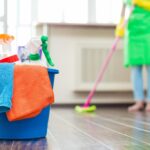The average person spends 90% of their time inside, which leaves a lot of room for New York City residents to be exposed to numerous indoor pollutants that can impact their health. Mold, allergens, volatile organic compounds (VOCs), and combustion pollutants are all common contaminants that need to be dealt with. This article covers some of the pollutants commonly found in NYC homes and highlights how mold inspection experts in NYC can help you identify and manage these hazards.
Why Indoor Air Quality Matters
Indoor air quality (IAQ) plays a huge role in health, since indoor pollutants can contribute to respiratory issues, aggravated allergies, headaches, and in more severe cases, conditions like heart disease or cancer. Research shows that pollutant levels indoors are often two to five times higher than outdoor levels because many NYC residences have poor ventilation. For many New Yorkers—especially young children, the elderly, and those with chronic conditions—poor IAQ can have a particularly noticeable impact.
Common Indoor Pollutants in NYC Residences
Indoor pollutants generally fall into three categories: biological, chemical, and combustion pollutants. Understanding each type and how to address them will help you create a healthier home environment.
1. Biological Pollutants
- Mold: Mold spores are common outdoors, and can easily get into homes through doors, windows, and ventilation systems. They thrive in moist environments, so areas with leaks or high humidity are especially vulnerable. Mold-related respiratory issues, like wheezing and coughing, are especially difficult for people with asthma or allergies.
- Allergens: Dust mites, pet dander, and pollen are other biological pollutants often found in NYC apartments. Although dust mites are nearly universal, pollen and dander can increase respiratory issues for allergy sufferers, particularly if their spaces are poorly ventilated. NYC’s higher asthma hospitalization rates for children demonstrate the need for allergen control in city homes.
2. Chemical Pollutants
- Volatile Organic Compounds (VOCs): VOCs, like those emitted from paints, cleaning products, and furniture, are among the most common indoor chemical pollutants. These compounds release gases that can lead to headaches, respiratory issues, and nausea. VOC concentrations indoors are frequently two to five times higher than outdoors, especially in newly renovated homes.
- Lead and Asbestos: Many older NYC buildings still have lead-based paints and asbestos from construction before they were made illegal. Lead exposure can cause cognitive impairment, so it’s particularly dangerous for children. Surveys of NYC neighborhoods with older housing have found elevated lead exposure levels among children, so those in such homes need to pay extra attention.
3. Combustion Pollutants
- Carbon Monoxide: This odorless, colorless gas is a byproduct of burning fuel and can build up indoors if appliances like furnaces or gas stoves aren’t properly vented or maintained. Carbon monoxide poisoning is a leading cause of accidental poisoning in the U.S., making regular testing important for homes with fuel-burning appliances.
- Secondhand Smoke: Cigarette smoke adds to indoor air pollution with over 7,000 chemical compounds that linger in the air. In NYC’s dense apartment complexes, avoiding secondhand smoke can be hard, especially in multi-family buildings.
The Role of Mold Inspection and Indoor Air Quality Testing
Because there’s such a huge variety of pollutants in NYC homes, maintaining a healthy environment requires comprehensive inspections. These inspections assess mold, allergens, VOCs, and other hazards through specialized testing methods, offering customized recommendations for each issue.
Mold Inspections
Mold inspections focus on identifying moisture issues, water damage, and humidity, all of which encourage mold growth. Experts collect samples from suspected areas, then analyze mold types and levels to recommend removal and preventive measures. Mold inspection experts in NYC understand the high humidity and age of many buildings, so they can meet the unique needs of local residents.
VOC and Lead Testing
Inspections for VOCs involve air sampling, while lead testing requires surface and dust samples, especially in older homes. Reducing VOC levels may include removing sources like fresh furnishings or improving ventilation, while lead mitigation generally requires professional intervention, particularly for peeling paint or renovations.
Carbon Monoxide and Combustion Pollutant Monitoring
For detecting carbon monoxide and other combustion pollutants, inspectors use sensors and air quality monitors. Routine maintenance and well-planned ventilation for fuel-burning appliances play a big role in avoiding hazardous buildup. Inspections help determine whether upgrades, like venting improvements, are necessary to keep indoor air safe.
Practical Steps for NYC Residents to Improve Indoor Air Quality
Maintaining clean, healthy indoor air requires taking proactive steps alongside inspection services. Here are practical measures you can take:
- Regulate Humidity: Keeping indoor humidity between 30-50% makes it harder for mold and dust mite to grow. Dehumidifiers are especially helpful in NYC’s humid summer months.
- Use Air Purifiers with HEPA Filters: HEPA air purifiers are effective at capturing dust, pollen, and mold spores, as well as larger allergens, creating a cleaner indoor environment.
- Choose Low-VOC Products: Picking low-VOC or VOC-free products whenever possible, and allow new furnishings or freshly painted surfaces to air out before use. This step can help reduce exposure to VOCs, which are often significantly higher indoors than outdoors.
- Inspect and Maintain Appliances Regularly: Annual inspections for gas and oil-based appliances, along with testing smoke and carbon monoxide detectors, help prevent buildup of combustion pollutants. These checks are key to keeping your home environment safe.
Creating a Healthier Home
Indoor air quality impacts overall health and comfort, especially in NYC homes where pollutants like mold, VOCs, and combustion gases can accumulate. Consulting with mold inspection experts in NYC allows residents to identify and address these hazards through tailored inspections and remediation strategies. By taking steps to control humidity, reduce VOCs, and maintain good ventilation, residents can significantly improve their indoor environment.
For anyone looking to boost their home’s air quality, scheduling an inspection is a proactive step toward a healthier living space. Mold inspection experts in NYC bring professional insights that can help create a safer, cleaner, and more comfortable indoor environment.
Resources
https://www.nyc.gov/site/doh/health/health-topics/indoor-air-quality.page







